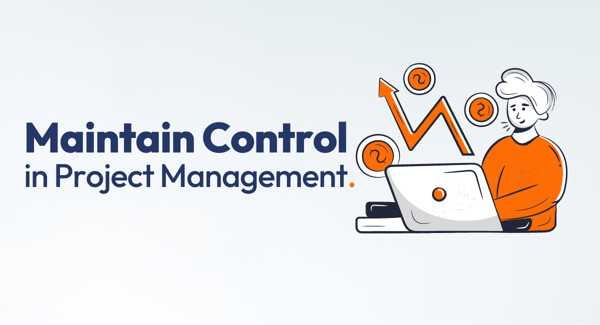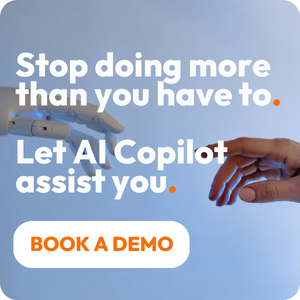Share this
5 Tips to Maintain Control in Project Management
by Juliette Lagerweij on December 6, 2023

Some of the best project managers are known to be self-proclaimed control freaks, both a good and a bad thing, depending on who you ask.
But when managing multiple projects at once and dealing with different teams (sometimes across the world), even the best of the best can find their projects suddenly spinning out of control.
The cost of supplies might increase. You might get a bottleneck if your team gets overloaded. There are countless scenarios that can make you feel like you’ve lost your footing.
The world’s best project managers lead their teams; they don’t rule over them. But when a project spins out of control, it can be a big challenge not to fall into the bad habits of a control freak. And this is only going to alienate your team.
Never fear, there’s always a way to hop back in the driver’s seat. Check out our 5 tips on how to regain and maintain control throughout the lifecycle of your project.
1. Create a risk management plan
As part of your project planning, don’t forget to create a risk management plan. This will force you to think about how to deal with potential interruptions and work clogs along the way.
A risk in project management is a potential disruption that could affect the outcome of the project. Usually, potential risks will be defined as any event that could alter the scope, budget, or timeline.
To develop your risk management plan, first identify potential risks. Then, you’ll need to do some analysis as to how these risks could potentially impact different aspects of the project. For example, risk A would extend the project timeline by one week; risk B would end up costing around $1,000.
Next, figure out what needs to be done if each risk comes to fruition, including specific tasks, resources to complete those tasks, and lines of communication, i.e. which stakeholders will be notified, etc.
By creating a risk management plan and following it, you won’t lose control when something goes awry. Here are a few risk management templates and examples to get you started.
2. Keep recurring meetings brief and utilitarian
Holding regular meetings is a super-effective way to stay in control of your project. However, superfluous meetings can hinder your progress and unnecessarily interrupt the workflows of key resources that may be on tight deadlines.
We’re not saying not to have recurring meetings, as these are necessary to keep a team cohesive and keep stakeholders in the know who need to know.
The key to successful meetings during the life of your project is to keep them brief and completely utilitarian. This will promote efficiency and place you in the driver’s seat of the project progress.
The beauty of the 30-minute meeting is that they are by nature, action-oriented. To make sure your progress meetings meet your utilitarian goals, prepare adequately beforehand, keep an eye on the clock, and if you can, do them with small groups, aka only those who absolutely need to be involved.
3. Be the all-seeing eye
It may sound sinister, but to maintain a high level of control, you need to be the all-seeing eye. This doesn’t mean you have to micromanage, on the contrary.
To become the all-seeing eye into your project status, all you need to do is use the right tools. An example is a project dashboard, where you can easily see at-a-glance how much money has been spent, how much time, etc.
Another example is a reporting feature, where you can plug in specific metrics, like profitability, and run a report that gives you what you need to see by way of cold, hard data.
An additional feature project managers love is the almighty Kanban board, a true window into the task management of each project. Kanban boards not only give managers and owners supreme visibility, but team members, too. Everyone can quickly understand what tasks are complete, overdue, and yet-to-be-accomplished with this handy visual aid.
FYI – Project management software will usually come with dashboards, reporting, and Kanban boards out of the box. So it’s just a matter of you utilizing these features and personalizing them to reflect your project goals.
4. Leverage predictive analysis
AI is a hot topic in countless sectors these days, but robust project management tools like PSA solutions have already been utilizing this technology for years in the form of predictive analysis.
Predictive analysis learns from your project data, both current and in the past, in order to predict possible future outcomes. In fact, predictive analysis can essentially be part of your risk management plan.
If you leverage this feature, you can get automatically alerted to budget and timeline issues way before they arise. Think of predictive analysis as your ultimate safeguard to prevent your project from ever going off rail (provided of course, you act on the information it provides you).
5. Keep workloads balanced
Finally, one of the biggest reasons projects can spiral out of control are imbalanced workloads. People can get overloaded very quickly, and if you don’t catch it, you can unwittingly start incurring more costs and/or jeopardizing the deadlines of the deliverables.
If you don’t want bottlenecks, especially in projects with a ton of dependencies, a good way to stay in control is with capacity planning and tracking.
A capacity planner will let you see in real time what everyone has on their plate. For simpler projects with smaller teams, you can do this on a task basis. In this case, when you look at your team’s capacity, you’ll see how many tasks are assigned to each person, what’s completed, and what’s not, along with the total capacity of each resource.
For more complex projects, you may need to plan and track capacity by the hour. A good resource management solution will let you do both task-based and hours-based capacity.
Be sure to regularly check your team’s workloads and capacities. You can configure this onto your dashboard. Take action whenever necessary to shift work around, if possible, to prevent bottlenecks and burnout.
Stay in control with the right software
All-in-one project management software can empower you to stay in control of your projects by helping you execute all the above tips. A solution like PSOhub gives project managers the ultimate visibility with easy-to-use tools and self-driving features. Take PSOhub for a spin today for FREE and supercharge your operational efficiency.
Share this
- Project Management (82)
- Productivity (61)
- Time Tracking (26)
- PSA Software (24)
- HubSpot (20)
- Resource Management (13)
- Invoicing (12)
- Salesforce (11)
- AI (7)
- Contract Management (7)
- Profitability (6)
- Gantt Chart (4)
- Microsoft Dynamics (4)
- Budget Management (3)
- Financial services (3)
- Integrations (3)
- Quickbooks (3)
- Quote (3)
- ROI (3)
- Traffic Management (3)
- collaboration (3)
- Consultancy (2)
- Digital Marketing & Advertising (2)
- Pipedrive (2)
- Work Management (2)
- About PSOhub (1)
- Automation (1)
- IT Companies (1)
- Risk Management (1)
- Ticket Sync (1)
- Workload Management (1)
- power bi (1)
- April 2025 (2)
- March 2025 (3)
- February 2025 (3)
- January 2025 (3)
- December 2024 (1)
- November 2024 (5)
- October 2024 (5)
- September 2024 (1)
- August 2024 (4)
- July 2024 (3)
- June 2024 (5)
- May 2024 (4)
- April 2024 (5)
- March 2024 (5)
- February 2024 (4)
- January 2024 (3)
- December 2023 (2)
- November 2023 (7)
- October 2023 (5)
- August 2023 (6)
- July 2023 (2)
- June 2023 (4)
- May 2023 (4)
- April 2023 (3)
- March 2023 (4)
- February 2023 (4)
- January 2023 (3)
- December 2022 (5)
- November 2022 (3)
- October 2022 (4)
- September 2022 (5)
- August 2022 (7)
- July 2022 (1)
- June 2022 (7)
- May 2022 (6)
- April 2022 (2)
- March 2022 (2)
- February 2022 (4)
- January 2022 (4)
- December 2021 (5)
- November 2021 (2)
- October 2021 (2)
- September 2021 (3)
- August 2021 (3)
- July 2021 (2)
- June 2021 (2)
- May 2021 (3)
- April 2021 (2)
- March 2021 (2)
- February 2021 (3)
- January 2021 (5)
- December 2020 (4)
- November 2020 (2)
- October 2020 (4)
- September 2020 (5)
- August 2020 (4)
- July 2020 (4)
- June 2020 (1)
- May 2020 (4)
- April 2020 (8)
- March 2020 (7)



